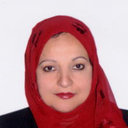Orodental, ear and eye anomalies in Egyptian Brachmann de Lange syndrome cases.
Keywords
Abstract
The Brachmann de Lange syndrome (BDLS), first described in its full clinical presentation by Brachmann (1916) and Cornelia de Lange (1933) is a multi-system syndrome involving congenital malformations, growth retardation and neurodevelopmental delay. We describe here twelve Egyptian cases with this syndrome with emphasis on the orodental, ear and eye abnormalities and their relation to the severity of expreseion of the disorder. The crodental anomalies were high arched palate, Iong philtrum, micrognathia, macrostomia hypoplasia of upper anterior teceth, fissured tongue macroglossia. Ear malformations were low-set large ears. Otoscopy revealed normal drum appearance. Audiogram revealed conductive, sensorineural or mixed hearing loss. Ocular manifestations were nystagmus, convergentt squint, enophthalmos, myopia 8 blue scleca. The study emphasizes certain eye, ear and crodental anomalies as diagnostic features of the BDLS which correlate with the severity of expression of the syndrome. None of the cases had chromosomal aberrations and the parental consanguinity rate was not increased thus supporting dominant mutations or minor chromosomal etiology.


